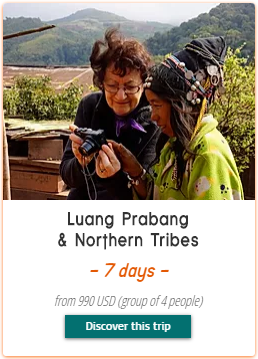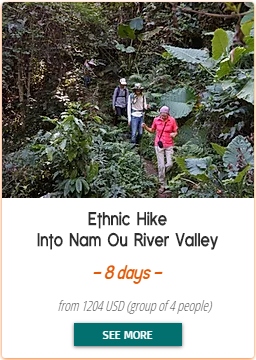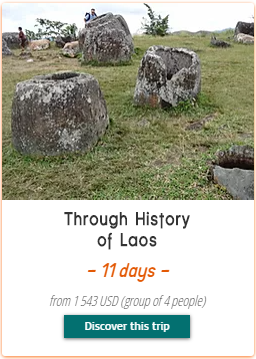Focus on Laotian handicraft : Pottery making at Ban Chane village
- Charly Renaudin

- Sep 20, 2019
- 5 min read
Updated: Jul 24, 2020
Handicraft is an important part of a country’s culture. It’s linked to its daily life, its history and its people. Northern Laos is still a rural area; thus, several objects are still homemade by local tribes. Bamboo baskets, silk scarves, mulberry paper are few examples of these very rich local traditions. How do they make it? How it’s linked to their daily life? Why do they keep doing it whereas it’s not needed anymore? How is this science transmitted? So many questions that we will answer. As it’s not our field of knowledge, we asked for help from experts. In this article, we focus on pottery with Thieng of Ban Chane Pottery village. Located on the other side of the Mekong river, only 4km from Ban Xieng Mene, it’s a must-do while you stay in Luang Prabang. Enjoy the reading !

Sabaidee Thieng. Can you briefly introduce Ban Chane Pottery Village to us?
The Ban Chane village has been making pottery for centuries now. Do you know the legend about it? Well, 400 years ago, the first king of Laos won a battle. He decided to organize a huge party to celebrate this victory. But at that time the only source of water was the Mekong river. And he needed many jars to carry it. Then, he visited Ban Chane and saw that the clay here was better than in any other place around Luang Prabang. So, he decided that this village would be responsible for making hundreds of jars to carry water from the Mekong to the place of celebration. That’s how Ban Chane started making pottery. And this legend has been told from elders to youngers for centuries now 😊
In the nineties, tourists have started to come to Laos. The tourism bureau of Luang Prabang wanted to promote this handicraft. That’s why, since then, they have done many things to improve the working condition of local potters. They have paved the road in the village, built the “pottery exhibition & demonstration center Ban Chane Neua” and they are currently building a brand-new kiln for ceramic. Moreover, they have sent several villagers to Thailand and Japan to get trained for new technics about ceramic and thus diversify the products.


What kind of objects Ban Chane village can make ?
What we can make with pottery has no limit. The potters of Ban Chane village mostly work for hotels and resorts. They produce big jars, vases and also lampshades for outdoor lighting. For tourists, they make small souvenirs that can easily fit in luggage such as animals, ashtrays, or coffee cups.
What is the process to make pottery? Any specific tool required ?
First, we have to dig for the raw material: the clay. Then, we grind it in powder like you can do for coffee. After, we soak it in water for 1 to 7 days, and obtain something like mud. But we need something strong, so we knead it with our feet. At that moment, we have the base to start making pottery.

To shape it, we use the turning wheel. It is mainly manual, but we also have an electric one for big jars. Once it’s shaped, we put it in the kiln. Let talk about it as it’s quite a process in itself.
First, you place in the kiln all that you want to bake. But the heat has to increase gradually, otherwise, your jars will crack. So, you begin with only 2 or 3 pieces of wood burning. After 2-3 hours, you add more and more wood for around 12 hours. Once the clay becomes red, you add more wood, and wait for 12 more hours.
Now, you have to leave everything in the kiln for around 3 days. So, the whole process can take from 4 to 5 days. And finally, we can send it to the customers.
Is pottery specific to a particular area of Laos ? Or a certain ethnic group ?
Not really. It mainly depends of the quality of the soil. If you have good clay and water in your village, it can be a good place to start doing pottery.
How is this craft transmitted from elders to youngers ?
As many forms of handicraft in Laos, the elders teach to the youngsters. It has been like this for 400 years in the village.
What was your aim when you decided to join this village in 2017 ?
When I arrived in this village, more and more local people were leaving the place. They were stopping making pottery because they didn’t get enough money from it. Young people didn’t want to learn that handicraft because they knew they couldn’t earn a decent living with it. They preferred to go working in hotels or restaurants of Luang Prabang. When I came to this village, I felt very sad about it. I thought that, going this way, all the knowledge would be lost in a generation. That’s why I decided to start a preservation campaign. Selling jars was not sustainable so I decided to organize handicraft workshops. This way, we would attract tourists and earn money. Therefore, young villagers would realize that they can live from pottery and keep the tradition alive. Moreover, meeting foreigners would help them be more open minded, learn new things, share knowledges, and therefore make their job more interesting.
The people that work for you have a particular background. Can you tell us more about that ?
Well, I wanted to social aspect to this place. I wanted to give local youngsters in difficulty the chance to get a job. That’s why I employ mainly disabled people, drug addicts, or the ones who have spent time in jail. We teach them a new job, allowing them to get a salary. And, on the other hand, they know they have to be committed because if they lose this job, it will be hard for them to find a new one.
What kind of activity/workshop do you offer to share this knowledge ?
We offer very workshops showing the full process of pottery making. From collecting the clay to bake the jars, the customers will see everything. These tours are suitable for kids, actually, they really enjoy using the turning wheel. My objective is to preserve this handicraft. That’s why I so my best to make people understand the importance of it, and how it’s linked to the Laotian living style.
We would like to thank Thieng of Pottery House Lao food, for all these details (or contact them by facebook). It’s so pleasant to hear an expert talking about what he loves. We hope that, through this article, you have learnt a lot about this particular type of handicraft. And if you are curious about bamboo braiding, silk weaving, or mulberry paper making, stay tuned ! Moreover, if you want us to organize your trip in Laos and make you discover local culture, feel free to contact us. See you soon !
#pottery #clay #banchane #banchanevillage #luangprabang #handicraft #visitlaos #travellaos #laos #potteryhouselaofood #potteryhouse




















Comments